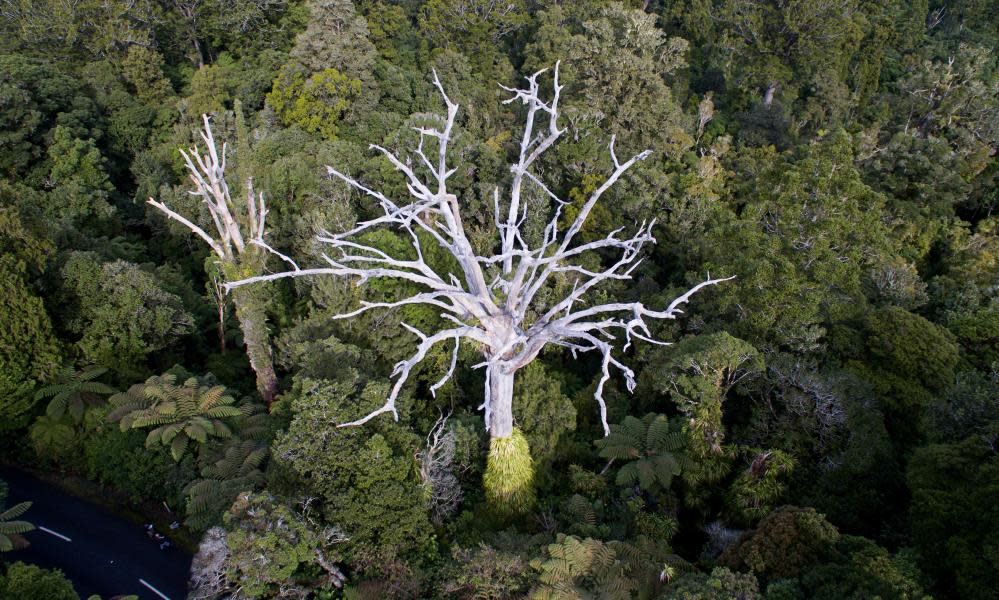Walking death: 'entitled locals' hiking New Zealand's kauri trees into extinction

A deadly fungal disease putting a treasured species of New Zealand native trees at risk of extinction has generated desperate attempts by Auckland park rangers to prevent the spread in what they believe is an “unprecedented” conservation effort globally.
But their efforts to bar hikers in areas most at risk of kauri dieback are foiled, they say, not by clueless tourists but by “entitled” locals who will not accept their favourite walking routes being disrupted.
Tracks in regional parks around Auckland have been closed to try to reduce the risk of the spread of kauri dieback, a fungus that can be spread by as little as a pinhead of soil on the sole of a hiker’s boots. Since it was first diagnosed in 2008 it has put the survival of kauri at risk. There is no cure, and stopping the disease from spreading is the only known way to save what remains of the species.
Kauri are the majestic kings of New Zealand’s native forest, and are of deep spiritual and historic significance to New Zealand’s indigenous Māori people. They live for more than 1,000 years – although the oldest is 2,500 years – and can grow to about 50 metres tall and 13 metres around.
The effort to save them has not been easy. In a 10-day operation over Christmas, authorities in Auckland said 14 people were found in barred spots. The trespassers were issued notices banning them from those parks for up to two years. Another four received formal warnings, and the cases of two others are under consideration. The culprits were mostly locals who knew they were breaching orders to stay off the tracks.
Related: 'Like losing family': time may be running out for New Zealand's most sacred tree
“The types of things we’ve heard is that they understand the issue but believe that they are able to manage themselves appropriately,” said Rachel Kelleher, the regional park manager for Auckland council. “Because they feel they can manage themselves appropriately, they believe they’ve got a different entitlement to others.”
However, there were not only fears about the spread of the fungus in and out of each park, with the risk of another area being infected if a hiker’s shoes were worn elsewhere, but also the spread of the disease within each park, where some areas are pristine but others are badly infected. Scientists say just one person is enough to spread soil that could infect an entire forest.
While there could be other culprits, such as pigs, birds or rats, Kelleher said: “A pig in the Waitakere ranges doesn’t go and get in its car at the end of the weekend and drive to a complete new forest.”
The scale of the challenge, particularly in the Waitakere ranges west of Auckland, was enormous. She said New Zealand could be unique in facing a tree pest control problem in such a large area that was also so accessible to the public.
“I don’t believe that there has been any situation where we’ve thought to close an area of that kind of geographic size, with that kind of visitor use profile of over a million visitors a year,” she said, referring to the Waitakere ranges area.
There, 16,000ha of regional park are dotted with more than 90 formal entrance points and 200km of walking tracks. Compliance officers rely on cameras and spot checks to catch people using closed tracks.
‘Twenty people could wipe out 20 forests’
In some spots this summer fences barring hikers from accessing certain areas had been vandalised or removed.
However, officials say awareness of the disease has increased and most people had stayed off the closed tracks. But it had been disappointing to find so many people breaking the rules, said Steve Pearce, the council’s regulatory compliance manager.
“Twenty people, any one of them could have easily wiped out a forest or two or 20,” he said, adding that two years ago he could not have imagined issuing trespass notices for the New Zealand bush over a tree pest.
“It’s really depressing when you go out and see these big, white dead [kauri],” he said.
When kauri die they take on a ghostly white appearance.
“It’s so shocking to see the significant change in the forest since this disease has been known,” Pearce said.
Agencies and local authorities around New Zealand are sharing information about the disease’s spread. But it was frustrating that a national plan for kauri dieback, which was first suggested by New Zealand’s government in 2017 and would create a consistent national approach, had failed to materialise.

“If central government would step up and provide more funding and provide more rigour to it, that’d be great,” said Pearce.
Jenny Salesa, a Labour party MP, said the national plan to combat kauri dieback was “progressing”.
“In budget 2019, our government announced a new investment of $20.75m over the next four years into kauri dieback research,” she said.
Related: First hiker charged in New Zealand with entering quarantined kauri forest
While Auckland council said it would continue its enforcement efforts and work to upgrade infrastructure of the tracks – with some trails reopened as rangers assessed the spread of the fungus could be managed – it will be years before scientists know whether keeping people off the paths was enough to save the kauri.
“There’s no guarantees,” said Lisa Tolich, Auckland council’s biosecurity team manager. “There’s still a lot of gaps in the science.”
Those gaps included whether other native species were hosting the fungus, and its long latency period. The length of time from when a forest is infected to the time when symptoms materialise can be 15 years.
“In the meantime, we’ve had to draw a line in the sand and say, managing risk and doing what we can in the absence of the knowledge, what is the least risk we can take?” Tolich said.


